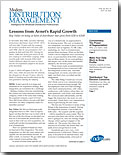
We analyze the qualitative results of our 1Q24 Baird-MDM Distribution Survey question that asked distributors about current or expected impacts from geopolitical issues.
All your exclusive premium content in one location.

This article looks at what concerns distributors most about the upcoming election, as noted in a recent MDM survey. In addition to the survey, MDM spoke with distributor associations that are playing an active role in educating and speaking for their members on critical topics in Washington DC.
While the election does not directly determine laws and regulations, the winners of the races – from the President down to local contests – will play a role in the country’s direction for the next several years.
It’s important for distributors to make sure their voices are being heard.
And it’s important for “everyone to …

Table of Contents:
Are you a subscriber? Simply log-in to view this issue.`
In November, Roy Vallee, executive chairman of electronics distributor Avnet (NYSE: AVT), will retire after 35 years with the company. He served as president and COO from 1992 until 1998, when he was promoted to CEO - a position he held until July 2011. During his tenure, Vallee saw Avnet grow from a $2 billion company to a $26 billion company. Vallee recently spoke with Associate Editor Jenel Stelton-Holtmeier about his career at Avnet and the role acquisitions played in the success of the distributor.
MDM: Avnet's growth is in large part attributed to its acquisition strategy. But integration can sometimes be a challenge - finding a balance between maintaining the culture and what attracted Avnet to the company while at the same time making the acquired company a part of Avnet. How did Avnet achieve success with this? And how can other companies make it a smoother process?
Roy Vallee: We did our first large-scale integration back in 1993. And we had to figure out then the best way to deal with it. But one of the first things we decided was that we'd document the process that we used so that with our next acquisition, we could ...



Many privately held distributors have advisory boards, but they are comprised entirely of insiders. Or the board is convened merely as a formality or legality. But a so-called real board" could help in formulating and enforcing company strategy, as well as provide a venue to ensure your wishes are carried out after you retire or in the case of a disabling injury or death.
Julia Klein, president and CEO of building materials distributor CH Briggs Co., Reading, PA, created an advisory board for her third-generation business about 18 months ago.
"I can tell you, it's one of the best things I've ever done," she says. "We had what many family businesses had -a perfunctory family board where we would pretend to meet over dinner, once a year, and have our lawyer write ...
Modern Distribution Management's May Inflation Index, which measures a cross-section of industrial supplies, was up 0.18% from the previous month, and up 3.5% from May 2006.
Summary of  ; MDM Inflation Index for the past 12 months:
May 2007 Index 271.2
April 2007 Index 270.8
March 2007 Index 269.6
February 2007 Index 269.4
January 2007 Index 268.7
December 2006 Index  ; 267.1
November 2006 Index 266.5
October 2006 Index 265.9
September 2006 Index 265.6
August 2006 Index 265.2
July 2006 Index 264.0
June 2006 Index 263.0
May 2006 Index 262.1
Please click below to view a print-ready pdf of the  ; MDM Inflation Index for May 2007, listing the ten individual product categories that make ...
Economic activity in the manufacturing sector expanded in June for the fifth consecutive month, while the overall economy grew for the 68th consecutive month, say the nation's supply executives in the latest Manufacturing ISM Report On Business.  ;
Following a weak first quarter, the manufacturing sector rebounded in a strong fashion during the second quarter. In June, manufacturing expanded at its fastest pace since April 2006 when the PMI Index registered 56.9. This performance appears sustainable in the third quarter due to the current strength in New Orders and Production.  ;
The 12 industries reporting growth in June & mdash; listed in order & mdash; are: Petroleum & Coal Products; Chemical Products; Plastics & Rubber Products; Food, Beverage ...

Work with a banking partner that knows your business. Get detailed information on investment banks with expertise in the wholesale distribution industry.





Build strategic sales plans.
Determine market and demand.
Create smart prospect lists.
Turn your sales data into actionable data with Market Prospector. A web-based SAAS tool that gives you insight into your market, your territories, your customers and new prospects too.
Our daily newsletter is your best source for news and trends in the wholesale distribution industry.
Wholesale distribution news and trends delivered right to your inbox.
Sign-up for our free newsletter and get:

By providing your email, you agree to receive announcements from us and our partners for our newsletter, events, surveys, and partner resources per MDM Terms & Conditions. You can withdraw consent at any time.